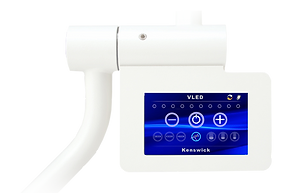

VLED
The most ergonomic LED Surgical light
The VLED light is designed in a way that no unnecessary parts can stay. The thickness of the light is less than 4.5cm which is one of the thinnest surgical light in the market.
The light head is made of aluminium alloy which facilities the heat dissipation when delivering the highest illumination of 160,000 lux. The temperature of the light head is extremely low at bout 1.5 - 2.0 deg. higher than the room temperature.
VLED Technology
Kenswick adopts the latest technology of white leds which are very small (only 3 x 3mm) and have a very narrow beam angle which provides efficient injection into the specialized optics for surgical applications. Only 84 leds are used to provide the highest light intensity of 160,000 lux, while a big light field of up to 30cm can be achieved. The low thermal resistance of 7K/W makes also thermal management much admirable and the temperature increase on the light head and the surgical site are minimized. Two options of VLED are provided, VLED double white (for changing color temperatures) and single white (single color temperature) for users to choose.
The VLED surgical light is designed and manufactured in accordance with the IEC standards of 60601-1, 60601-1-2, and 60601-2-41 (safety requirement for surgical luminaires and luminaires for diagnosis), and in conformity with European Medical Device Regulation 2017/745 (CE marked). The light performance meets or exceeds every single requirements for different surgical applications.
360 degree movement
Thanks to the most advanced control technology, the light head can be freely rotated with 360 degrees, it helps the medical staff to position the light head more accurately and conveniently to the surgical site, enchancing a better view of the surgery.

Movement w/o limit

170cm
Best light column
VLED, unlike the traditional led surgical lights, can provide a very long light column of 1700mm, by means of the different intensity adjustment from the different angled lensed leds electronically.
Variable light field sizes
Apart from the very long and homogeneous light column, the VLED also provides different light field sizes from 200 to 300 mm, while maintaining the same light intensity even after the adjustment. This important feature give the surgeons options to operate from small to big wounds, and without the phenomenon of excessive reflection from the surroundings or insufficient light intensity.
Other Unique Features & Benefits
.png)
-1.png)

Optimal for laminar flow
Thanks to the most ergonomic design of VLED, the shape is extremely streamlined to minimize any turbulence of the laminar flow (Leeneman index is ~3.9). In addition, the whole body of VLED is made of aluminium to ensure optimum heat management, increase in temperature of light head is barely noticeable, which allows handling the illumination even more comfortable.
Intuitive touch control
VLED further enhances the concept of user-friendliness, the 5-inch LCD touch screen helps operating nurses to quickly adapt to the control interface. In addition, the interface incorporates the control of Vision HD camera at the same control panel, minimizing the user to shift from one equipment to another.
Outstanding CRI = 97
With colour rendering index Ra over 97, the surgeon recognizes clearly the tiniest nuances of colour in tissue.
For recognizing the exact colour spectrum of the wound the exact rendition of the red colour range is essential. R9 (red) ≥ 95 means for the surgeon a visibly better recognition of details. The colour spectrum of the wound is rendered naturally with rich contrast. The OT-light clearly provides welcome relief for your eyes.

Fat Beam Illumination
Intensity
Field Size
Most evenly distributed light
Traditional surgical lights create a high intensity by squashing the light flux into the middle of the beam, creating a “central spot”. However, the VLED provides a more fat beam (evenly distributed) illumination. This means the vision of the surgical site will become more homogeneous providing more comforts for the surgeons, and of course then, the patient safety is highly enhanced.


Variable color temperature
The color temperature can be varied in 3 steps 3800K, 4300K and 4800K. As a result, surgeons always have the optimum visual conditions depending on the extent of perfusion of the surgical site. Usually the color temperature of 3800K is particularly applicable for orthopaedic surgery, while the higher color temperature of 4800K is well suited for neurosurgery of which white tissue needs to be highlighted for better vision. This range of color temperature provides “better illumination” for the surgeries.
No rainbow effect
Since VLED merges the double white leds by computer calculated optical system with facetted lens, this produces only white light and is dispersed over the wound field more homogeneously. The color shadows in the light beam by “traditional LED lights” caused by the surgeon’s head, shoulder and hands are avoided by this new technology.
